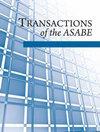脉冲电场结合热超声对黄酒理化性质的影响
IF 1.4
4区 农林科学
Q3 AGRICULTURAL ENGINEERING
引用次数: 2
摘要
与单独治疗相比,TS-PEF减少了颜色变化。经PEF和TS-PEF处理后,Fe、Cr、Ni浓度升高。经TS和TS- pef处理后,挥发性风味物质有所减少。中国黄酒(CRW)是一种流行于东亚的传统酒。在目前瓶装CRW的工业生产中,为了延长产品的保质期,在装瓶阶段需要进行额外的高温巴氏杀菌,这种热处理会导致质量下降,甚至致癌物质的形成。在我们之前的研究中,脉冲电场(PEF)、热超声(TS)及其组合(TS-PEF)等非热技术已被证明可以显著灭活CRW中的酿酒酵母,作为瓶装葡萄酒热巴氏灭菌的替代方法。然而,关于它们对CRW质量影响的研究非常有限。在这项研究中,我们比较了巴氏杀菌、PEF、TS和TS-PEF处理的CRW的理化性质。结果表明,不同处理对CRW的基本理化指标(总糖、非糖固形物、总酸度、氨基酸氮和pH)均无显著影响。TS-PEF处理减少了TS或PEF处理引起的总色差。然而,在PEF和TS-PEF处理过程中,电极的腐蚀导致铁、铬和镍浓度显著增加。此外,挥发性风味化合物,如醇类、酯类、酸类和醛类,经TS和TS-PEF处理后比经巴氏灭菌和PEF处理后减少得更多。在有效灭菌的背景下,如何将这些新技术对CRW风味的负面影响降到最低,还需要进一步的研究。关键词:黄酒,金属离子,理化性质,脉冲电场,超声,挥发性风味化合物本文章由计算机程序翻译,如有差异,请以英文原文为准。
Impact of Pulsed Electric Fields Combined with Thermosonication on the Physicochemical Properties of Chinese Rice Wine
HighlightsThe TS-PEF diminished the color change compared to individual treatments.The concentration of Fe, Cr, and Ni increased after the treatments of PEF and TS-PEF.The volatile flavor compounds decreased after the treatment of TS and TS-PEF.Abstract. Chinese rice wine (CRW) is a traditional wine prevalent in East Asia. In current industrial production of bottled CRW, an additional thermal pasteurization is required at the bottling stage to extend the shelf life of the product, and this thermal treatment results in quality degradation and even carcinogen formation. In our previous studies, non-thermal technologies such as pulsed electric fields (PEF), thermosonication (TS), and their combination (TS-PEF) have been shown to significantly inactivate Saccharomyces cerevisiae in CRW as an alternative to thermal pasteurization of bottled wine. However, studies of their effects on the quality of CRW are very limited. In this study, we compared the physicochemical properties of CRW treated by pasteurization, PEF, TS, and TS-PEF. The results showed that the basic physicochemical indicators of CRW (total sugar, non-sugar solids, total acidity, amino acid nitrogen, and pH) did not change significantly after all these treatments. The TS-PEF treatment reduced the total color difference caused by the TS or PEF treatments. However, corrosion of the electrodes during PEF and TS-PEF treatment caused a significant increase in iron, chromium, and nickel concentrations. In addition, volatile flavor compounds, such as alcohols, esters, acids, and aldehydes, were reduced much more after TS and TS-PEF treatment than after pasteurization and PEF. Further research is needed on minimizing the negative impacts of these new technologies on the flavor of CRW in the context of effective sterilization. Keywords: Chinese rice wine, Metal ion, Physicochemical properties, Pulsed electric fields, Ultrasound, Volatile flavor compounds.
求助全文
通过发布文献求助,成功后即可免费获取论文全文。
去求助
来源期刊

Transactions of the ASABE
AGRICULTURAL ENGINEERING-
CiteScore
2.30
自引率
0.00%
发文量
0
审稿时长
6 months
期刊介绍:
This peer-reviewed journal publishes research that advances the engineering of agricultural, food, and biological systems. Submissions must include original data, analysis or design, or synthesis of existing information; research information for the improvement of education, design, construction, or manufacturing practice; or significant and convincing evidence that confirms and strengthens the findings of others or that revises ideas or challenges accepted theory.
 求助内容:
求助内容: 应助结果提醒方式:
应助结果提醒方式:


